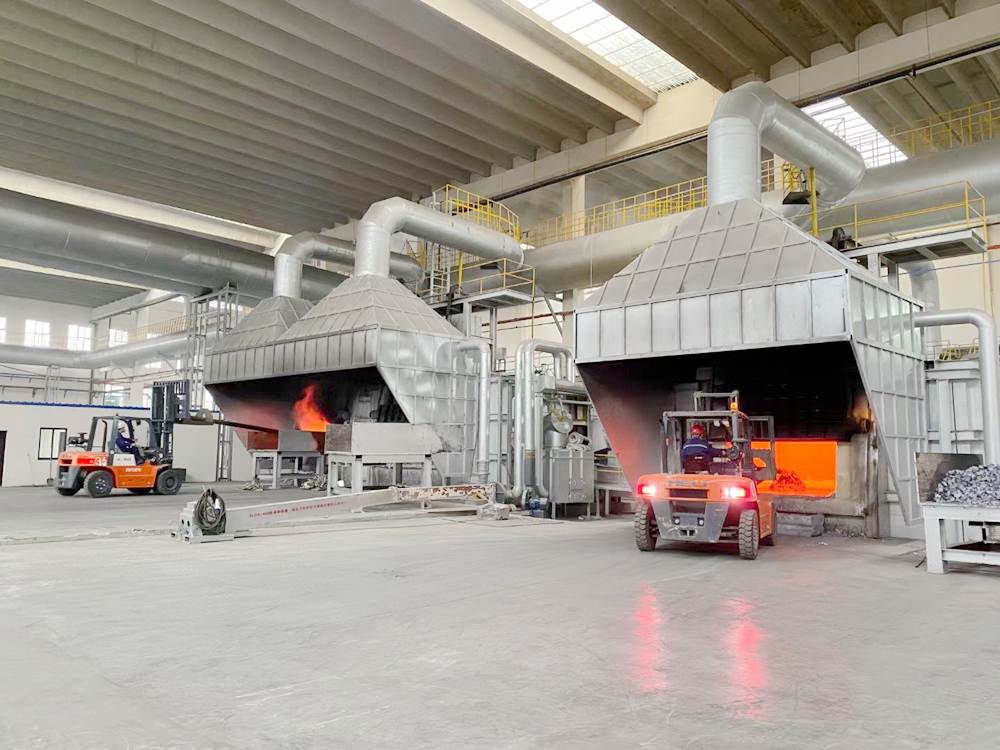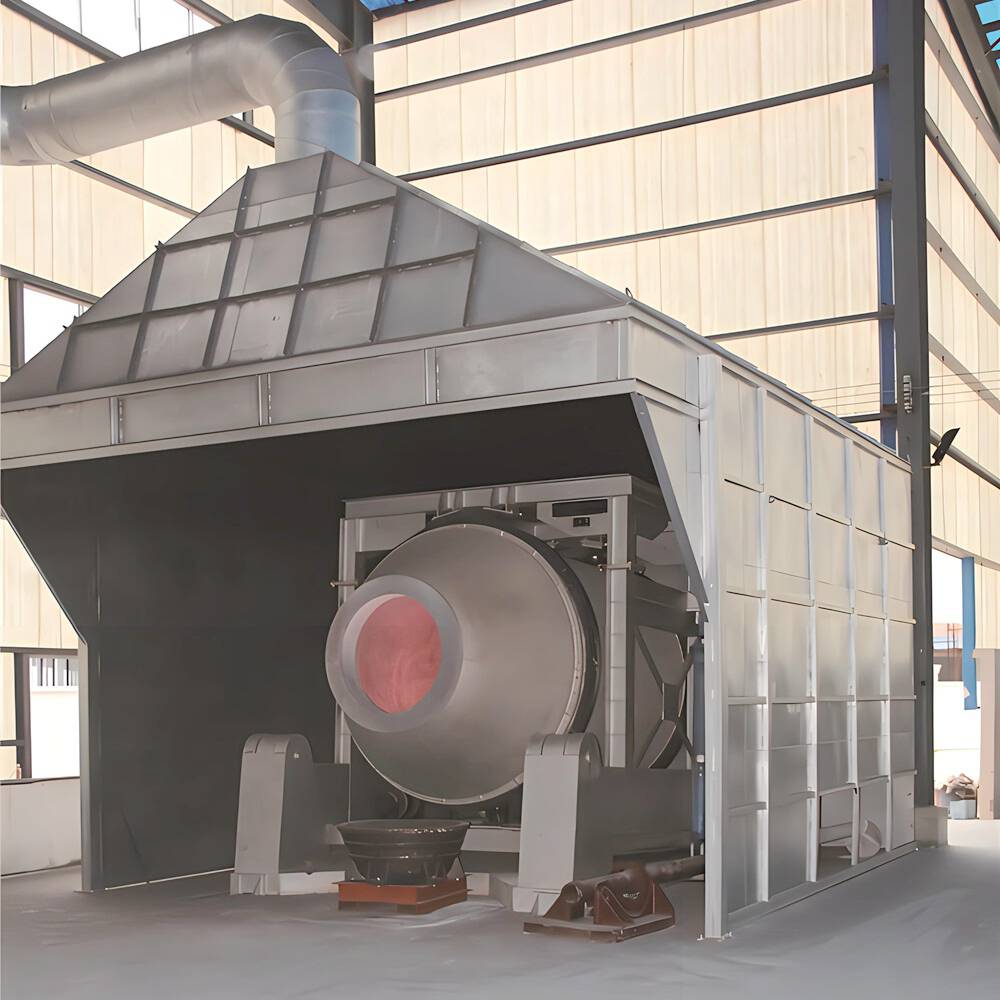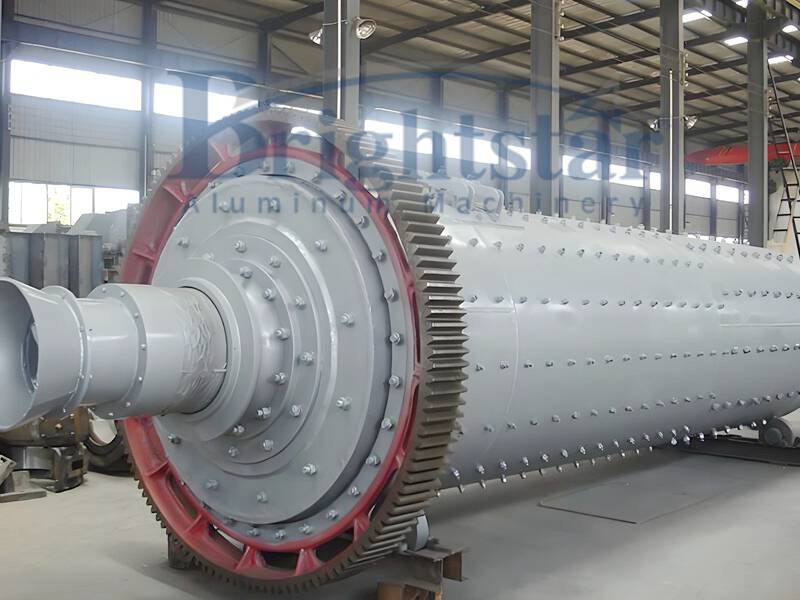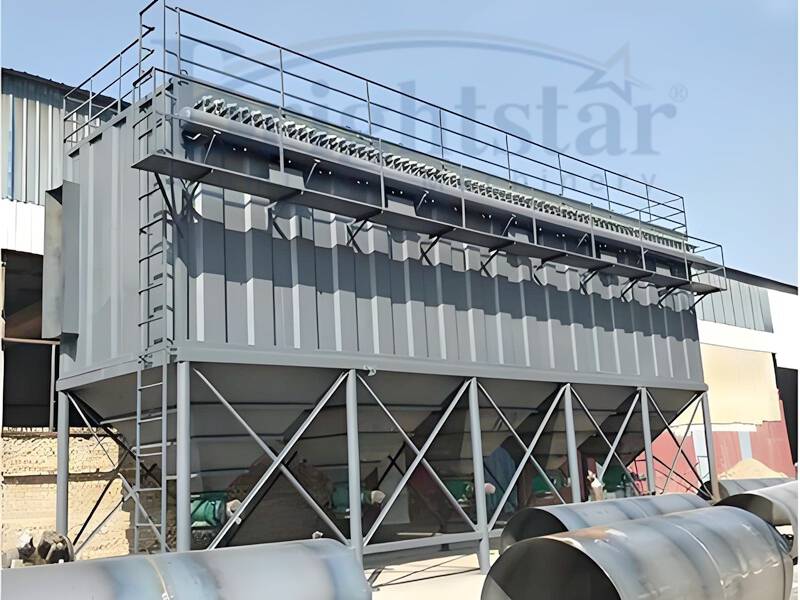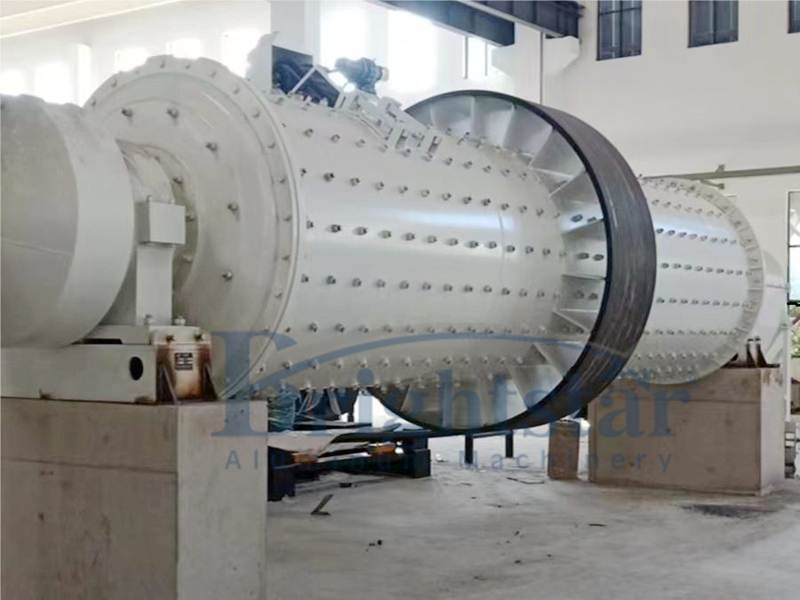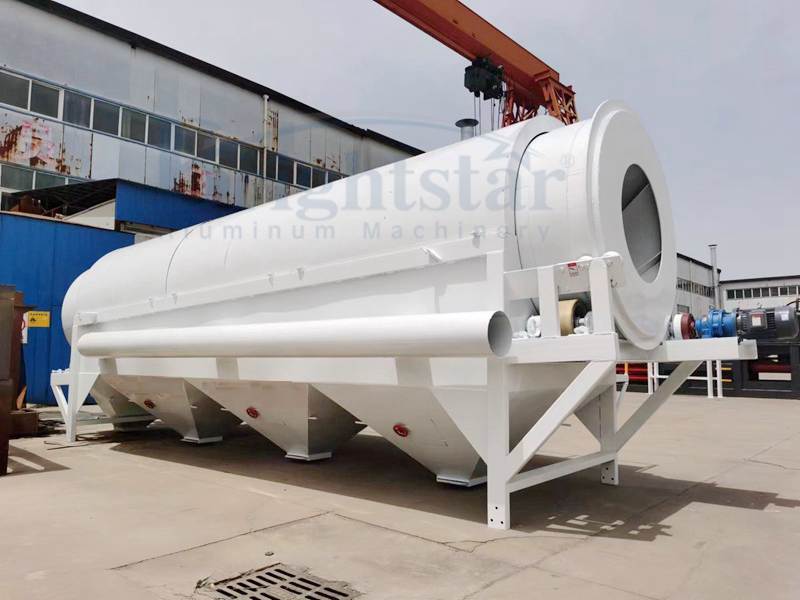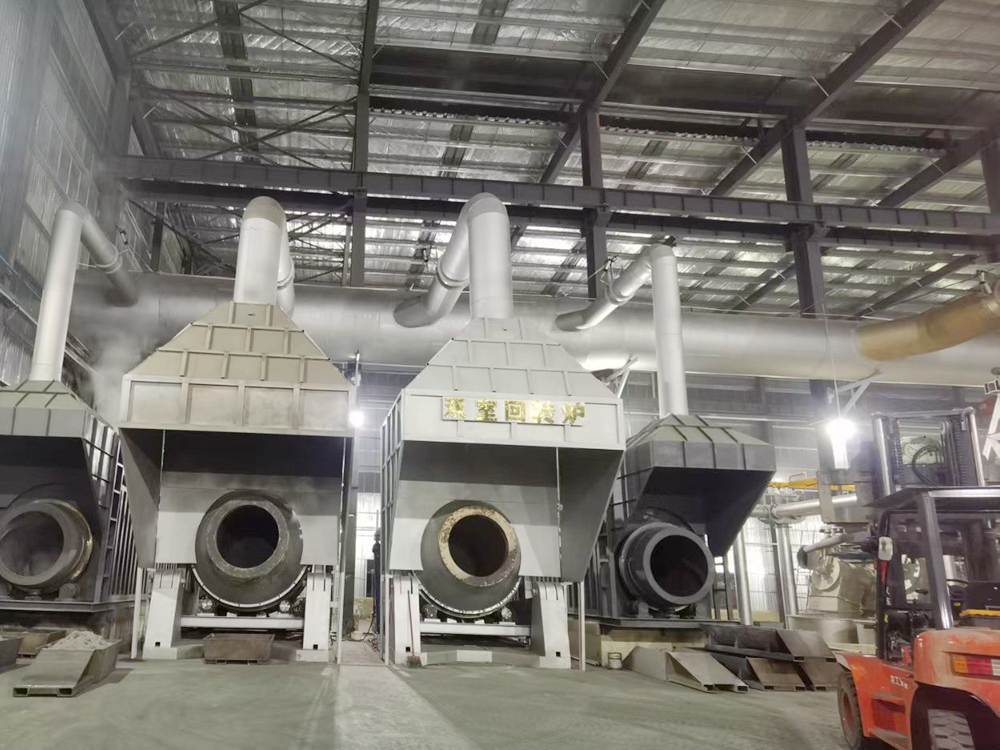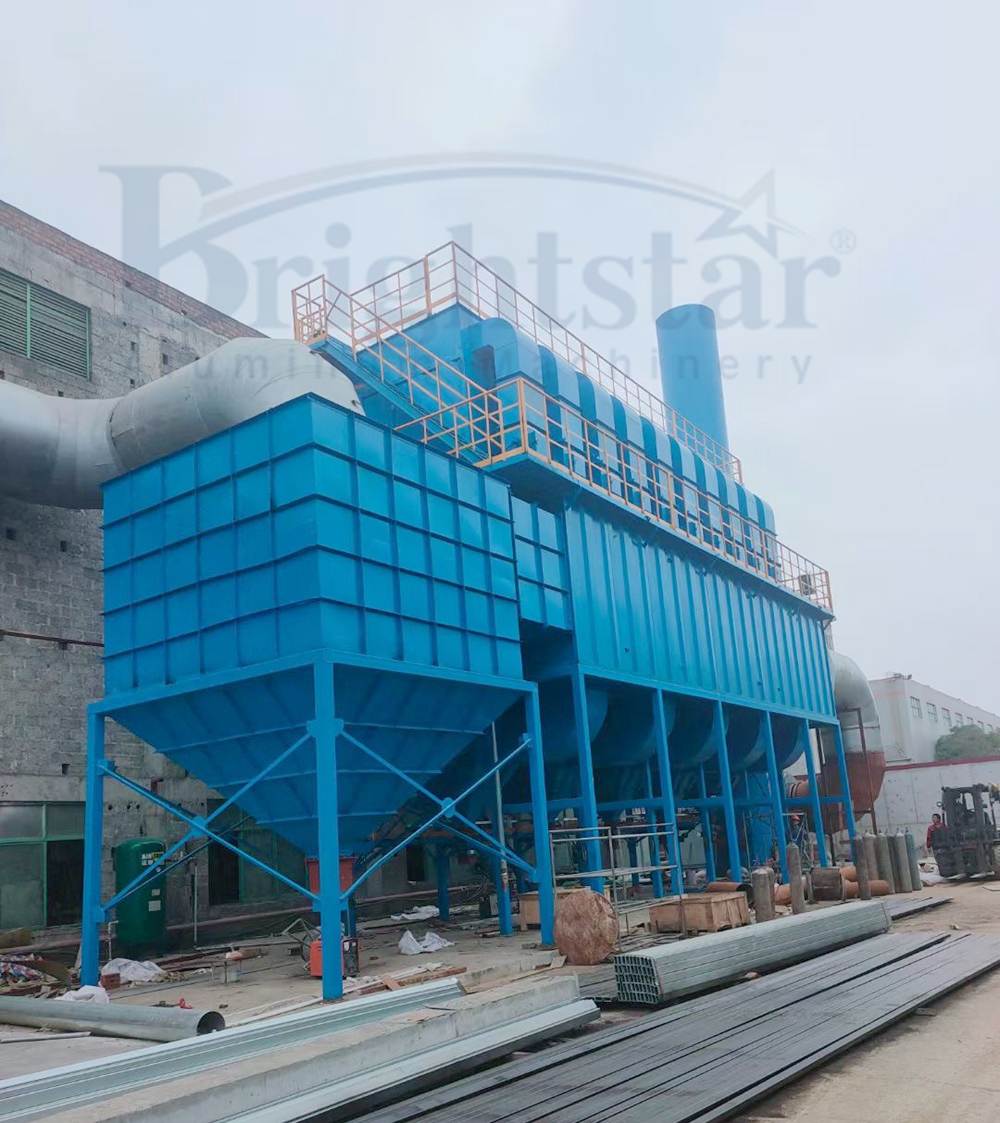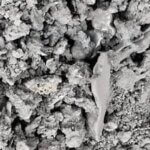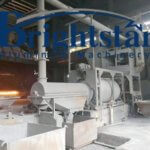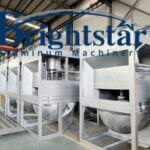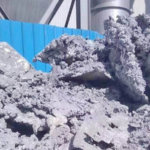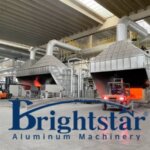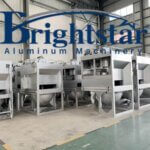Secondary aluminum dross harmless treatment process project case
Secondary aluminum dross harmless treatment process project case
Aluminum dross is the slag generated during the production process of electrolytic aluminum or cast aluminum, which is a hazardous solid waste.
Aluminum dross contains aluminum elements, alumina, aluminum carbide, silicon, fluoride, chloride and other components
Among them, alumina accounts for more than 70% and has a high recycling value.
Aluminum dross is divided into primary aluminum dross, secondary aluminum dross.
The domestic secondary aluminum dross treatment processes mainly include the fire process, wet process, and combined fire and wet processes.
Among them, the fire process mainly includes the resource-based rotary kiln process;
The wet process mainly includes the deamination- fluorine retention-green recycling process;
The combination of fire and wet processes includes the “multi-stage continuous enhanced hydrolysis leaching + high value directional conversion” process , fire method high temperature calcination combined with polyaluminum chloride process, wet process for salt extraction, fire process for calcium aluminate process.
The above processes mainly focus on the consideration of resource utilization after wet deamination and fluorine fixation, as well as the consideration of resource utilization after direct fluoride fixation and denitrification by fire method.
However, during the actual project implementation process, due to the above process, the processing volume is 10,000 tons and the investment is huge, the factories’ willingness to invest is not strong.
Therefore, this article briefly introduces the miniaturized harmless disposal scheme of secondary aluminum dross based on the actual situation of secondary aluminum dross treatment.
Introduction to 6000-8000 tons/year secondary aluminum dross harmlessness treatment process project
Process description
Secondary aluminum dross harmless production process flow
The raw material of this production process is secondary aluminum dross.
After removing iron from the secondary aluminum dross, it is crushed, ground, and screened to separate the aluminum and dross powder until the aluminum content approaches zero.
In this way, the secondary aluminum dross is fully activated, it has the conditions for full combustion.
The appropriate ratio of secondary aluminum dross and limestone is sent to the large calcining furnace through automatic conveying equipment, and then hot is added or the secondary aluminum dross is ignited through burner.
The secondary aluminum dross spontaneously ignites to produce high-temperature conditions where aluminum nitride reacts, releasing heat.
This heat will fully calcine and denitrify the aluminum nitride contained in the secondary aluminum dross, removing the reactivity and combustibility of the secondary aluminum dross.
At the same time, calcium oxide is added to solidify fluorine according to the composition of the secondary aluminum dross for harmless treatment.
The harmless materials that have been reacted in the furnace are cooled and classified, and finally a qualified finished product is obtained.
The main component of the finished product is CaO·Al2O3(Ca(AlO2)2), which is used as a raw material in the fields of building materials, metallurgy, refractory materials and water purification agents, etc.
The main advantages of the process flow for producing calcium aluminate from aluminum dross:
1. Use aluminum dross to produce calcium aluminate refining agent.
Turn waste into treasure, benefit the country and the people, and save energy.
It is calcined with aluminum dross and limestone in a rotary kiln.
There is no pollution and no residue to produce refining agent.
2. The use of calcium aluminate refining agents in steel-making furnaces plays the role of deoxidation, desulfurization, slagging, and improving the quality of steel.
Currently, this product has been exported to Europe, Japan, South Korea, India and other countries, and has been well received by foreign users. .
3. Using aluminum dross to produce calcium aluminate refining agent reduces the use of bauxite, saves the country’s mineral resources, and solves the problem of aluminum dross pollution.
4. Recycle some high-purity aluminum products to produce better economic benefits and social and environmental benefits.
5. The aluminum refining process does not involve any chemical process, and the process is safe and controllable.
The calcium aluminate refining slag production device uses rotary kiln equipment.
The production process is safe and environmentally friendly, and complies with relevant national industry guidance policies.
6. No secondary waste residue/dross pollution is produced, and 100% of the aluminum dross is recycled.
Sintered calcium aluminate is a white mineral material made from kaolin and lime by sintering at high temperatures.
It has excellent physical and chemical properties and a wide range of uses.
1. Construction field: Sintered calcium aluminate can be used as a high-grade cement additive, which can significantly improve the performance of cement, making it have higher strength and better durability.
It is widely used in high-rise buildings, water conservancy projects, ports and terminals, etc. In large projects.
2. Metal smelting field: Sintered calcium aluminate can be used as a smelting aid.
Adding an appropriate amount of sintered calcium aluminate during the smelting process can lower the melting point of the metal, improve the fluidity of the slag, reduce energy consumption, and improve production efficiency.
3. Environmental protection field: Sintered calcium aluminate can also be used as a flue gas desulfurizer and is widely used in power plants and chemical companies where desulfurization is required.
It can absorb harmful substances such as sulfur dioxide in fuel, thereby reducing environmental pollution and protecting the ecological environment.
4. Other fields: Sintered calcium aluminate can also be used as fuel additives, catalysts, carbon black whitening agents, etc.
In summary, sintered calcium aluminate has a wide range of uses and has been widely used in construction, metal smelting, environmental protection and other fields.
With the continuous advancement of science and technology and the continuous expansion of application scope, sintered calcium aluminate will play a more important role and become the new favorite in the future field.
Secondary aluminum dross crushing and screening
First, the secondary aluminum dross is removed from iron and transported to the feeding port of the crushing, grinding and screening machines through an automatic conveyor.
Granular aluminum and fine dross are screened out.
The fine dross is automatically lifted to the feed bin on the top of the 10T high-temperature calcining furnace for use.
The aluminum particle enters the dross machine or rotary furnace for metal aluminum recycling. Fine dross enters the aluminum dross harmlessness system.
Aluminum dross harmless treatment
CaO, secondary aluminum dross, and powder collected by the dust collector are transported to the calcining furnace of the aluminum dross harmless system through automatic equipment for denitrification and fluorine fixation.
Denitrification reaction(nitrogen-free reaction)
Theoretical analysis of oxidative thermal decomposition of aluminum nitride
Between 600-800°C, the first endothermic peak of aluminum dross appears, mainly due to the oxidation of aluminum nitride into alumina.
In addition, the heat flow curve in the 600-800°C region shows an obvious downward trend, and aluminum nitride oxidation mainly originates from this temperature region.
After 1100℃, the secondary aluminum dross is basically in a weightless state, and most of the aluminum nitride has been oxidized at this time.
Therefore, during actual production, the temperature (1000-1100°C) and air flow of the 10T calcining furnace are controlled so that the aluminum nitride (AlN) in the aluminum dross undergoes an oxidation reaction under high temperature conditions.
In the process of setting the oxygen content and temperature Under such conditions, the nitrogen in the aluminum dross is converted into nitrogen gas, and the remaining nitrogen is converted into NOx.
According to the actual measurement data of nitrogen oxides produced by equipment that has been put into production, the concentration of nitrogen oxides produced by this reaction is low, and the concentration is generally 40-70mg/m³.
This concentration is far lower than the national emission indicator limit of 150mg/m³.
And more than 95% of the nitrogen in aluminum dross is converted into nitrogen, and there is no pungent smell at the production site.
Fluoride retention
The fluorine-fixing agent CaO and the like put into the rotary furnace cause the soluble fluorine element in the fine aluminum dross to undergo a fluorine-fixing reaction and convert it into insoluble fluoride.
The harmless fine aluminum dross after fluorine retention is inverted and the hot dross enters a closed dross hopper.
A forklift is used to send the dross hopper to an automatic closed tipping machine and then poured into the dross cooler.
Harmless treatment and finished product
The technological process for producing calcium aluminate from aluminum dross includes an aluminum dross ball mill and sieving system, a calcination system and an aluminum particles melting furnace or rotary furnace.
The aluminum dross sorting system mainly includes feeding, primary screening, primary ball milling, secondary screening, and secondary ball milling, etc. production processes.
The calcination system mainly includes production processes such as ball milling, rotary kiln calcination, cooling, screening, rough crushing, ball milling, and bagging.
The aluminum particle melting system mainly includes feeding, melting, cooling, ingot casting and other production processes.
The proposed project uses aluminum dross and secondary aluminum dross produced by aluminum processing and electrolytic aluminum enterprises as raw materials.
The aluminum particles obtained after being processed by the aluminum dross sorting system enter the aluminum particle melting system to produce aluminum ingots, and the remaining part enters calcination.
The system uses natural gas as fuel to burn the aluminum dross and secondary aluminum dross and limestone mixture put into the rotary kiln to produce calcium aluminate products.
The process of preparing calcium aluminate by high-temperature calcination of aluminum dross is as follows:
1.First, crushed aluminum dross with the ball mill
2. Put the aluminum dross powder into a calcine furnace and perform high-temperature calcination treatment in an oxygen atmosphere.
3. During the calcination process, the alumina in the aluminum dross will react with ammonia to form ammonium aluminite.
4.After calcination, ammonium aluminite decomposes at high temperature to form ammonia and aluminum oxide.
5. After calcination, alumina reacts with caustic soda (such as calcium hydroxide) to form calcium aluminate.
6. Finally, the calcined calcium aluminate is obtained, which can be subjected to subsequent fine processing to obtain high-purity calcium aluminate.
The reaction mechanism of calcium aluminate prepared by high-temperature calcination of aluminum dross is as follows:
2Al2O3 + 2NH4OH → (NH4)2[Al(OH)4]
(NH4)2[Al(OH)4] → 2NH3 + Al2O3 + 6H2O
Al2O3 + 2NaOH → Na2O·Al2O3 + H2O
Na2O·Al2O3 + CO2 + H2O → 2NaHCO3·Al(OH)3
NaHCO3·Al(OH)3 → NaAl(OH)4 + CO2 + H2O
2NaAl(OH)4 → Na2SO4 + Al(OH)3 + 2H2O
Al(OH)3 → Al2O3 + 3H2O
It can be seen that aluminum dross reacts with ammonia water in a high-temperature oxygen atmosphere to form ammonium aluminite, then decomposes to form ammonia and aluminum oxide, and finally reacts with caustic soda (such as calcium hydroxide) to form calcium aluminate.
Environmental assessment
The main sources of waste gas pollution in this plan include: smoke (powder) dust, fluoride, SO2, NOx waste gas, unorganized waste gas in the workshop, etc. generated by the rotary furnace treatment and comprehensive utilization system used for aluminum dross pretreatment and heat treatment.
There is no wastewater discharge in the process of this plan.
Domestic sewage is treated by the company’s integrated domestic sewage treatment facilities and reused for plant greening and dust reduction without discharge.
The noise in this scheme is mainly the noise of mechanical equipment.
The solid waste generated by this plan mainly includes: waste oil and domestic garbage generated from the maintenance of mechanical equipment, etc.
| Pollutant type | Number | Pollution source | Pollution factor | Emission mode | Measure |
| Exhaust gas | G1 | Dross machine | particulate matter | Intermittent | Baghouse dust collector and exhaust funnel |
| G2 | Cooler | particulate matter | Intermittent | ||
| G3 | Ball mill and sieving | particulate matter | Intermittent | ||
| G4 | Rotary furnace | particulate matter | Intermittent | ||
| Waste water | Office and sanitary waste water | pH, COD,BOD5, Ammonia nitrogen, SS | Intermittent | Company sewage station treatment | |
| Solid waste | S1 | Used oil | Used oil, metal chips | Intermittent | Qualified company processing |
| S2 | Office garbage | Intermittent | Sanitation department | ||
Equipment list and requirement
Secondary aluminum dross harmless treatment equipment list
Aluminum dross ball mill and sieving system with baghouse dust collector:
1 set of belt conveyor, 1 set of ball mill, 1 set of vibrating screen, 1 set of bucket lifter, 1 set of feeding bin, 1 set of baghouse dust collector
Aluminum particle melting equipment
1 set of rotary furnace, 1 set of dross cooler, 1 set of magnetic separating conveyor, 1 set of aluminum ingot casting line, 1 set of baghouse dust collector
Secondary aluminum dross calcining equipment
1 set of calcining furnace, 1 set of dross cooler, 1 set of screening machine, 1 set of screw conveyor, 1 set of baghouse dust collector.
This equipment is used to transport secondary aluminum dross for high-temperature calcination and harmless treatment.
Secondary aluminum dross
The secondary aluminum dross (hazardous waste) is transported to the factory in tons of bags, and then unloaded into the raw material warehouse for storage.
Aluminum dross enter the ball mill and sieving workshop, after being crushed and sieving processes, the separated aluminum enters the smelting workshop to be smelted into aluminum ingots and stored in the warehouse.
The sorting residue is mixed with limestone powder in a certain proportion and then preheated and entered into the rotary kiln to be calcined into a refining agent.
The main components of the mixed materials are Al2O3, Al, CaCO3, etc.
The mixed materials enter the calcine furnace and are calcined at high temperature to produce calcium aluminate CaO·Al2O3 (Ca(AlO2)2).
Equipment technical specification and requirement
| Main Technical Requirement |
| ⭐ Equipment list is as follows⭐ Secondary aluminum dross processing quantity 6000-8000T
⭐Conveying capacity: 10000T/Year for secondary aluminum dross conveying ⭐Calcine time: 6-8 hour/furnace ⭐Calcine temperature: 1100℃—1400℃ ⭐The finished product has no reactivity when soaked in water. It has been inspected by a third-party agency in accordance with relevant national standards to eliminate the hazardous attributes of hazardous waste. |
Equipment list details
| No. | Equipment | Model | QTY |
| 1 | Feed bin(include top cover) | 3000×3000 | 1 set |
| 2 | Belt conveyor | B500x5.5m | 1 set |
| 3 | Aluminum dross ball mill | Φ1200×4500 | 1 set |
| 4 | Bucket lifter | NE30x7m | 1 set |
| 5 | High efficiency grading screen machine | Φ1300×6500 | 1 set |
| 6 | Baghouse dust collector | BCC220-22 | 1 set |
| 7 | Rotary furnace | XZL-5T | 1 set |
| 8 | Dross cooler | LHT1600x15m | 1 set |
| 9 | Magnetic separation conveyor | CQ500x5.5m | 1 set |
| 10 | Baghouse dust collector | BCC700-90 | 1 set |
| 11 | Calcining furnace | DSL-12T | 1 set |
| 12 | Dross cooler | LHT2200x16m | 1 set |
| 13 | Screening after cooling | V1525 | 1 set |
| 14 | Screw conveyor | LS315x4.5m | 1 set |
| 15 | Baghouse dust collector | BCC1150-110 | 1 set |
Analysis of harmless treatment plan for secondary aluminum dross
Advantage analysis
Mature process principle:
The harmless treatment of secondary aluminum dross is to make full use of the trace amounts of elemental aluminum and aluminum nitride( aluminum nitride content in aluminum dross is 15-40%) contained in secondary aluminum dross (aluminum dross with an aluminum content of less than 8% after being processed) contacts with oxygen to produce a combustion reaction.
It releases a certain amount of heat, generates the high-temperature conditions required for the conversion of aluminum nitride into aluminum oxide and nitrogen, thereby achieves the purpose of transforming aluminum dross from hazardous waste properties to solid objects without hazardous properties.
Simple process:
The secondary aluminum dross harmlessness process adopts the following processes including grinding, sealed transportation, self-feeding and calcination, cooling and dust collection.
This technology has a high level of aluminum nitride conversion and no waste water and waste residue emissions.
Low energy consumption:
Since the production process does not require continuous natural gas and other energy sources, the natural gas is used for starting the furnace.
Only electricity is needed in the subsequent production process.
The overall power is about 400kw.
Each ton of secondary aluminum dross processed consumes about 120KWh, which is the lowest energy consumption level among all secondary aluminum dross harmless methods currently on the market.
High degree of automation and simple operation:
High-temperature calcining furnace – recycled aluminum companies are familiar with the operation of rotary furnaces.
High-temperature calcining furnaces are similar to rotary furnaces, and companies can quickly master high-temperature calcining furnaces.
Cost benefit:
This solution is a harmless disposal, with investment costs saved by 30-40% compared with traditional processes, operating costs saved by 70%, and energy consumption saved by about 80%.
The product is calcium aluminate, which has good market prospects and is a good choice for the harmless disposal of self-produced aluminum dross.
Summary and Outlook
As a fire method, the secondary aluminum dross fire harmless treatment process has the characteristics of low investment, small space, low operating cost, high degree of automation, simple operation, and good product market prospects.
It is understood that this treatment plan is used in some applications.
The company has completed production and construction and has been recognized by the environmental protection department.
The harmless treatment process product of secondary aluminum dross solves the reactivity of secondary aluminum dross.
The product has been identified as general solid waste.
From the current technical and policy level analysis, it has good market promotion value.
Contact us to obtain a reliable No-obligation quote for your secondary aluminium dross harmless treatment, turn the hazardous waste into the resouce.

